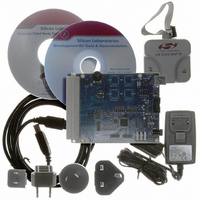C8051F700DK Silicon Laboratories Inc, C8051F700DK Datasheet - Page 5

C8051F700DK
Manufacturer Part Number
C8051F700DK
Description
DEV KIT FOR C8051F700
Manufacturer
Silicon Laboratories Inc
Type
MCUr
Datasheets
1.C8051F700-TB.pdf
(1 pages)
2.C8051F700-TB.pdf
(306 pages)
3.C8051F700-TB.pdf
(18 pages)
Specifications of C8051F700DK
Contents
Board, Cables, CD, Debugger, Power Supply
Processor To Be Evaluated
C8051F7x
Processor Series
C8051F7xx
Interface Type
USB
Operating Supply Voltage
3.3 V
Lead Free Status / RoHS Status
Lead free / RoHS Compliant
For Use With/related Products
C8051F7xx
Lead Free Status / Rohs Status
Lead free / RoHS Compliant
Other names
336-1635
4.4. System Requirements
The Silicon Laboratories IDE requirements:
4.5. Third-Party Toolsets
The Silicon Laboratories IDE has native support for many 8051 compilers. Natively-supported tools are as follows:
Specific instructions for integrating each of the supported tools can be found in the application notes section of the
CD, or on the Silicon Labs web site (http://www.silabs.com).
4.6. Getting Started With the Silicon Labs IDE
The following sections discuss how to create a new project with the IDE, build the source code, and download it to
the target device.
4.6.1. Creating a New Project
4.6.2. Building and Downloading the Program for Debugging
Pentium-class host PC running Windows 2000 or later.
One available USB port.
Keil
IAR
Raisonance
Tasking
Hi-Tech
SDCC
1. Select Project
2. Select File
3. Right-click on “New Project” in the Project Window. Select Add files to project. Select files in the file
4. For each of the files in the Project Window that you want assembled, compiled and linked into the target
1. Once all source files have been added to the target build, build the project by clicking on the Build/Make
2. Before connecting to the target device, several connection options may need to be set. Open the
3. Click the Connect button in the toolbar or select Debug
4. Download the project to the target by clicking the Download Code button in the toolbar.
ognized extension, such as .c, .h, or .asm, to enable color syntax highlighting.
browser and click Open. Continue adding files until all project files have been added.
build, right-click on the file name and select Add file to build. Each file will be assembled or compiled as
appropriate (based on file extension) and linked into the build of the absolute object file.
Note: If a project contains a large number of files, the “Group” feature of the IDE can be used to organize.
Right-click on “New Project” in the Project Window. Select Add Groups to project. Add pre-defined
groups or add customized groups. Right-click on the group name and choose Add file to group. Select files
to be added. Continue adding files until all project files have been added.
Project button in the toolbar or selecting Project
Note: After the project has been built the first time, the Build/Make Project command will only build the
files that have been changed since the previous build. To rebuild all files and project dependencies, click
on the Rebuild All button in the toolbar or select Project
Connection Options window by selecting Options
the “USB Debug Adapter” option. Next, the correct “Debug Interface” must be selected. C8051F700 devices
use Silicon Labs “C2” 2-wire debug interface. Once all the selections are made, click the OK button to close
the window.
New File to open an editor window. Create your source file(s) and save the file(s) with a rec-
New Project to open a new project and reset all configuration settings to default.
Rev. 0.2
Build/Make Project from the menu.
Connection Options... in the IDE menu. First, select
Connect from the menu to connect to the device.
Rebuild All from the menu.
C8051F700-DK
5










